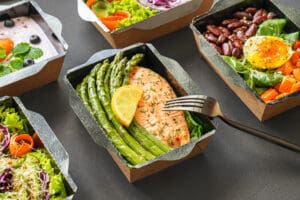
Consumers of all kinds are eager to enhance their sustainability efforts in today’s commercial landscape, with this translating significantly into their buying habits.
One such way that businesses can meet the increasing demand for conscious consumption is by embracing sustainable food packaging.
The food and beverage industry is often under scrutiny for its less-than-eco-friendly practices, such as factory farming, monocropping and so much more. Sustainable packaging for food and beverage products is becoming increasingly common, demonstrating a willingness in businesses to reduce environmental impacts and satisfy customer desires. This article will touch on some common eco-friendly food packaging solutions, elaborating on the positive impact they’re having on the industry and environment.
Sustainable food packaging trends
In recent years, several eco-friendly food packaging trends have started to emerge in several business settings, ranging from artisan producers to supermarkets.
Eco-friendly takeaway containers
Many restaurants and takeaways across the country have started to use alternatives to single-use plastic food and drink packaging, utilising biodegradable and recyclable containers, rather than plastic or styrofoam versions. Some of these containers will simply be made from cardboard, while others will be compostable.
Tinned beverage ‘Snap Packs’
Brands such as Carlsberg Group have successfully rolled out a new way of packaging tinned beers – the ‘Snap Pack’. This system has largely done away with the traditional plastic rings that have held together 4-6 packs of lager and ale, swapping them out for small spots of glue. This decision has been reported to have reduced Carlsberg’s plastic waste by around 76%.
Recycled shrink film
In another effort to reduce plastic waste, many supermarkets and drink and beverage producers have started to vacuum pack and shrink-wrap products, such as multipacks of bottled water. To further the sustainable value of vacuum-packing and shrink-wrapping, some packaging manufacturers have developed recycled films using the plastic recovered in oceanic cleanup schemes. This not only reduces the need for new plastic production but also supports waste prevention and recovery from the ocean.
Flexible drink packaging
Another emerging trend is the adoption of flexible drink pouches rather than typical bottles or cans. While these pouches are still often made from plastic, they’re significantly lighter than the alternatives. This makes them far more fuel—and space-efficient to transport and store, meaning they can support businesses aiming to reduce their carbon emissions.
Alternative water packaging
A development taking the food and beverage industry by storm is the introduction of alternative water packaging. Brands, such as CanO Water and Radnor Hills are embracing materials like cardboard, aluminium and the more traditional glass to package and distribute water. These different packages are becoming especially common in entertainment venues, such as nightclubs and concert halls.
These developments are all signs of the times. In a food and drink landscape with more and more options, it only makes sense that there will be more cases of environmentally friendly packaging! If you operate in this market, embracing these changes in packaging won’t just be good for the planet but good for your business as well.
Read more:
Sustainable Food Packaging: How Eco-Friendly Options are Changing The Food & Beverage Industry






